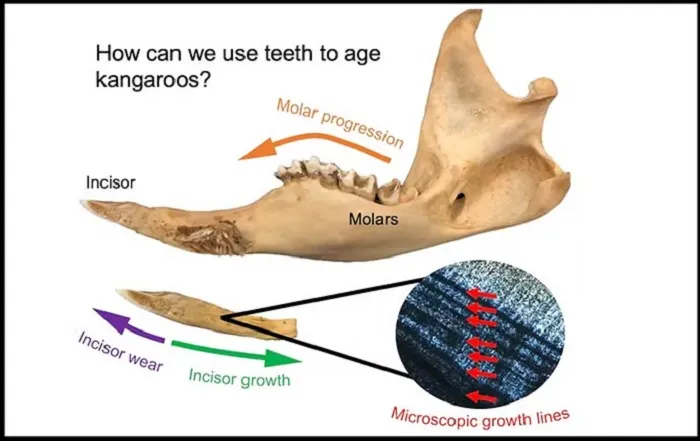A recent study led by biologists at Monash University and published in Archives of Oral Biology has introduced a new method to determine the age and sex of Australian marsupials by examining their teeth. The findings offer valuable insights for veterinarians, ecologists, and conservationists.
The study focused on kangaroos’ front teeth, called incisors, which can provide clues about both the animal’s age and gender. This discovery is crucial for understanding the health of wildlife populations.
In the wild, determining the age of animals can be challenging. Without a way to track birthdays, scientists often rely on animal teeth to gather this information. Most Australian marsupials, including kangaroos, koalas, wombats, and possums, have large, straight incisor teeth. These animals belong to the order Diprotodontia, which is known for its distinctive teeth.
The researchers measured the growth of incisors in three species: Eastern Grey Kangaroos, Western Gray Kangaroos, and the Honey Possum, which has fewer teeth. The study found that these incisors grow throughout the animal’s life, with their length serving as an indicator of age.
William Parker, a PhD candidate at Monash University and the study’s lead author, explained, “These incisors grow continuously, which allows us to estimate age based on their length.” Parker added that the findings are important for understanding marsupial evolution, as well as for population ecology and conservation efforts.
The incisors of marsupials grow in layers, similar to tree rings. These growth lines form as enamel, dentine, and cementum accumulate over time, providing a reliable record of the animal’s age. In kangaroos, scientists discovered that two regions of the incisor teeth show yearly growth lines.
Additionally, kangaroos’ molar teeth offer another way to determine age. Unlike most animals, kangaroos have a unique adaptation where their molars move forward in the jaw over time. As old, worn teeth are pushed out, new, unworn ones replace them, providing an accurate age indicator similar to how elephant teeth work.
The study also revealed differences between male and female kangaroos. “We found that male kangaroo incisors grow faster and wear down more quickly than those of females,” said Professor Alistair Evans, a co-author of the study. This difference may reflect varying feeding behaviors between the sexes.
The methods developed in this study also have the potential to help scientists learn more about extinct kangaroo species. Thousands of years ago, Australia was home to larger kangaroos, and fossilized teeth could provide insights into their age, gender, and ecology.
“Our new techniques can help determine the age and sex of these extinct animals from fossilized teeth, giving us a better understanding of their evolution,” Professor Evans said.
Related topics:

